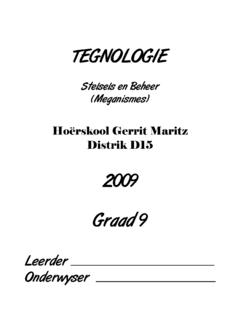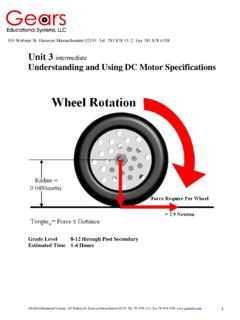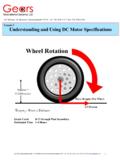Transcription of TECHNOLOGY - Tegnologie
1 TECHNOLOGYS ystems and Control(Mechanisms)Ho rskool Gerrit MaritzDistrict D152009 Grade 9 Learner _____Teacher _____CAPABILITY TASKIn this module you are going to design and make a mechanism to help Thabo solve his problem. You will use the knowledge you will obtain about mechanisms in order to comply with the given Specifications: use pulleys use gears give a mechanical advantageTo help you with your capability task you will complete various manufactured products can be thought of as systems. A system is a group of components connected so that they work together to perform a component parts may be ordered steps in a procedure or organizational structure but we need only concern ourselves with physical components each of which has its own contribution to make to the overall operation of a systems consist of at least three clearly identifiable sections. The input stage is where energy or information is fed into the system.
2 The process stage is where energy or information is processed or converted. The output stage causes something to happen. Grade 9 Systems & Control (Mechanisms)2 The energy source of the system will determine which type of component is required at each stage. If the energy source is compressed air the components will need to be pneumatic components and these will combine to produce a pneumatic system. If the energy source is electricity the components will need to be electrical or electronic and these will combine to produce an electronic or electrical system. The energy input into a system can be: Movement - (mechanical systems),Oil/water under pressure - (hydraulic systems),Air under pressure - (pneumatic systems),Electricity - (electrical or electronic systems).MECHANICAL SYSTEMSMOVEMENTT here are four basic kinds of motion, or movements:Linear motion movement in a straight line and in one directionReciprocating motion movement backwards and forwards in a straight lineOscillating motiona swinging back and forth Rotary motion a circular motion.
3 GearsGears are wheels with teeth. Gears can be used to slow things down or speed things up, change direction and/or control several things at once. Gears are wheels whose perimeter is made up of evenly sized and spaced teeth. The teeth of one gear mesh with those of an adjoining one and transmit rotary motion between the two gears. The driven gear always rotates in an opposite direction to the driving gear. If both gears have the same number of teeth, they will rotate at the same speed, however if they have different numbers of teeth then the gear with fewer teeth will rotate more quickly. A gear system is a combination of two or more gears working together. Two gears connected together turn in opposite directions; the gear upon which the effort force is being applied is the DRIVER gear and the other gear is the FOLLOWER (driven gear). By placing a gear (IDLER) between the driver and the follower gear, you can make the driver and follower gear turn in the same direction.
4 The smaller driver gear connected to a larger follower gear, results in slower speed, but greater force in the follower gear (gearing down). A larger driver gear, connected to a smaller follower gear results in faster speed, but less force in the follower gear (gearing up).There are different types of gears: spur gear, bevel gear, worm gear, rack and pinion. Grade 9 Systems & Control (Mechanisms)3 Types of gearsSpur gears Multiple gears can be connected together to form a gear train. If there are an odd number of gears, the output rotation will be the same direction as the input. If there are an even number, the output will rotate in the opposite direction to the input. Note that for the simple type of gear train shown, the number of teeth on the intermediate gears does not affect the overall velocity ratio which is governed purely by the number of teeth on the first and last cog. Bevel gearsBevel gears are used to change rotational movement through an angle of 90o.
5 Bevel gears will provide some mechanical advantage or increase in velocity ratio. Rack-and-spur gearsThe rack-and-spur gear is used to convert between rotary and linear motion. Often the spur rotates in a fixed position and the rack is free to move - this arrangement is used in the steering mechanism of most cars. Alternatively, the rack may be fixed and the spur rotates moving up and down the rack. This latter arrangement on two-handled cork-pullers. Rack-and-worm gearsThe rack-and-worm gear changes rotational movement into linear movement. In a shifting spanner, the rack-and-worm system is used to adjust the position of the jaw of the spanner to make the gap wider or narrower. The worm is turned to adjust the position of the spanner. So for each revolution of the worm, the rack advances the distance between two consecutive teeth on the rack. Grade 9 Systems & Control (Mechanisms)4 Worm-and-spur gearsA worm-and-spur gear is often used when a large speed reduction is required and not much power is needed.
6 Unlike ordinary gears, the motion is not reversible, a worm can drive a gear to reduce speed but a gear cannot drive a worm to increase it. The velocity ratio of two adjacent cogs can be calculated by dividing the number of teeth on the driven gear by the number of teeth on the driving gear. The velocity ratio of a worm-and-spur gears is easily calculated because the worm has only one tooth. The worm gear is always the drive gear. For example, if the wheel gear has 60 teeth and the worm gear has 1 tooth, then the velocity ratio is 1/60 = 1:60 Activity 1 The diagram below shows a fork lift truck. It is used to lift pallets, complete with their heavy loads. The forks on the front of the truck move up and down the vertical track. the magnified area, draw the missing mechanism that allows movement of the how the mechanism works_____(5)AssessmentAspectLevel 7(Mastered excellently)Level 6 (Meritoriously mastered )Level 4 (Adequately mastered)Level 2 (Elementary mastered)MarkLevel 5(Substantially mastered)Level 3(Moderately mastered)Level 1(Not mastered)Activity 1 Assignments completed and correct.
7 Obvious completed and correct. Some completed haphazardly. Hardly any incomplete. No 9 Systems & Control (Mechanisms)5 Activity 2:Look at the image on the left of the gears of a wine bottle opener. a) What type of gear system is this? _____b) Is this mechanism a force multiplier or speed multiplier? _____c) How does this machine make it easy to uncork the wine bottle?_____(3)Look at the ) Will this type of gearing produce speed or force multiplication. (2)Assessment AspectLevel 7(Mastered excellently)Level 6 (Meritoriously mastered )Level 4 (Adequately mastered)Level 2 (Elementary mastered)MarkLevel 5(Substantially mastered)Level 3(Moderately mastered)Level 1(Not mastered)Activity 2 Answers were logically planned and well structured and provide in-depth information Answers planned that provide information to suit the aim of the taskSome answers were given but not all are applicable to the aim of the taskIncomplete or could not answer questions___5 The spur gear is the simplest kind of gear.
8 It is a wheel with teeth around its gears can be connected together to form a gear there are an odd number of gears, the output rotation will be the same direction as the there is an even number, the output will rotate in the opposite direction to the 9 Systems & Control (Mechanisms)6In a simple gear train the number of teeth on the idler gears will have no effect on the overall gear ratio or velocity ratio. It is only determined by the teeth on the first and last compound gear trains (when there are more than one gear on an axle) the gear ratio and velocity ratio can be affected by die idler mechanical advantageGearing up and downWhen the driver gear is small and the driven gear is big, the big gear rotates slower this is called gearing down because the output is slower than the the driver gear is big and the driven gear is small, the smaller gear rotates faster this is called gearing up because the output is faster than the the mechanical advantage in gearsThe teeth on any set of gear wheels, that mesh together, are all exactly the same size.
9 If we put these two facts together, we can say that the number of teeth on any individual gear wheel (in a set of meshing gear wheels) is proportional to its diameter. Grade 9 Systems & Control (Mechanisms)7 Example:Gear A has 30 teeth and gear B has 20 teeth. If gear A turns one revolution, how many times will gear B turn ? Which gear revolves the fastest ? When gear 'A' completes one revolution gear 'B' turns revolutions (1 times) You should have also found the gear B revolves the fastest. A basic rule of gears is - if a large gear (gear A ) turns a small gear (gear B ) the speed the other hand, if a small gear turns a large gear the opposite happens and the speed 3:Look at the image on the left. Gear "B" has 36 teeth and gear "A" has the gear ratio of this gear train if "B" is the _____(3)Look at the image on the left. Gear "B" has 12 teeth and gear "A" has ) Calculate the gear ratio of this gear train if "B" is the (3)The hand drill on the left uses intermeshing bevel gears.
10 Gear "A" has 80 teeth while gear "B" has ) Which one is the driver? _____b) Calculate the gear ratio. _____ _____ _____(3)Grade 9 Systems & Control (Mechanisms)8 Assessment AspectLevel 7(Mastered excellently)Level 6 (Meritoriously mastered )Level 4 (Adequately mastered)Level 2 (Elementary mastered)MarkLevel 5(Substantially mastered)Level 3(Moderately mastered)Level 1(Not mastered)Activity 3 Answers were logically planned and well structured and provide in-depth information Answers planned that provide information to suit the aim of the taskSome answers were given but not all are applicable to the aim of the taskIncomplete or could not answer questions___12 Activity 4:a) If the motor turns in a clockwise direction, which direction will gear X turn ? _____ b) What is the name of the gear arrangement shown in the picture?













